Effects of Flavonoid Supplementation on Athletic Performance in Healthy Adults: A Systematic Review and Meta-Analysis
Abstract
:1. Introduction
2. Methods
2.1. Literature Search Strategies
2.2. Inclusion Criteria
- Studies were carried out on healthy adults without disease;
- Studies for which the experiments must contain randomized controlled trial;
- Studies for which the full text must be English.
2.3. Searching Procedure
- 148 records were obtained from specified four databases;
- After removing 66 duplicate records, 82 articles remained, from which we removed eight reviews and 13 non-human experimental studies again;
- A total of 61 articles met the eligibility criteria, and their full texts were assessed;
- After finishing a comprehensive and systematic evaluation, 38 articles were excluded, seven for which full texts were not found, 10 on unrelated subjects, 12 included another supplements, seven had unsuitable outcomes, two used abnormal healthy populations and one had insufficient data, respectively;
- Finally, a total of 22 studies were included for the meta-analysis.

2.4. Publication Bias
2.5. Quality Assessment of the Experiments
2.6. Data Extraction
2.7. Statistical Analysis
3. Results
3.1. Publication Bias
3.2. Quality Assessment of the Experiments
3.3. Study Characteristics
3.4. Performing a Meta-Analysis on Performance Tests
3.5. Performing a Meta-Analysis on Exercise Tolerance
4. Discussion
5. Conclusions
Author Contributions
Funding
Institutional Review Board Statement
Informed Consent Statement
Data Availability Statement
Acknowledgments
Conflicts of Interest
References
- Singh, B.; Kumar, A.; Malik, A.K. Flavonoids biosynthesis in plants and its further analysis by capillary electrophoresis. Electrophoresis 2017, 38, 820–832. [Google Scholar] [CrossRef] [PubMed]
- Steinberg, F.M.; Bearden, M.M.; Keen, C.L. Cocoa and chocolate flavonoids: Implications for cardiovascular health. J. Am. Diet. Assoc. 2003, 103, 215–223. [Google Scholar] [CrossRef] [PubMed]
- Baby, J.; Devan, A.R.; Kumar, A.R.; Gorantla, J.N.; Nair, B.; Aishwarya, T.S.; Nath, L.R. Cogent role of flavonoids as key orchestrators of chemoprevention of hepatocellular carcinoma: A review. J. Food Biochem. 2021, 45, e13761. [Google Scholar] [CrossRef] [PubMed]
- Rupasinghe, H.V. Special Issue “Flavonoids and Their Disease Prevention and Treatment Potential”: Recent Advances and Future Perspectives. Molecules 2020, 25, 4746. [Google Scholar] [CrossRef] [PubMed]
- García-Barrado, M.J.; Iglesias-Osma, M.C.; Pérez-García, E.; Carrero, S.; Blanco, E.J.; Carretero-Hernández, M.; Carretero, J. Role of flavonoids in the interactions among obesity, inflammation, and autophagy. Pharmaceuticals 2020, 13, 342. [Google Scholar] [CrossRef] [PubMed]
- Liskova, A.; Koklesova, L.; Samec, M.; Varghese, E.; Abotaleb, M.; Samuel, S.M.; Smejkal, K.; Biringer, K.; Petras, M.; Blahutova, D.; et al. Implications of flavonoids as potential modulators of cancer neovascularity. J. Cancer Res. Clin. Oncol. 2020, 146, 3079–3096. [Google Scholar] [CrossRef] [PubMed]
- Chen, Q.; Xu, B.; Huang, W.; Amrouche, A.T.; Maurizio, B.; Simal-Gandara, J.; Tundis, R.; Xiao, J.; Zou, L.; Lu, B. Edible flowers as functional raw materials: A review on anti-aging properties. Trends Food Sci. Technol. 2020, 106, 30–47. [Google Scholar] [CrossRef]
- Li, G.; Ding, K.; Qiao, Y.; Zhang, L.; Zheng, L.; Pan, T.; Zhang, L. Flavonoids Regulate Inflammation and Oxidative Stress in Cancer. Molecules 2020, 25, 5628. [Google Scholar] [CrossRef]
- Cichon, N.; Saluk-Bijak, J.; Gorniak, L.; Przyslo, L.; Bijak, M. Flavonoids as a Natural Enhancer of Neuroplasticity—An Overview of the Mechanism of Neurorestorative Action. Antioxidants 2020, 9, 1035. [Google Scholar] [CrossRef]
- Kressler, J.; Millard-Stafford, M.; Warren, G.L. Quercetin and endurance exercise capacity: A systematic review and meta-analysis. Med. Sci. Sports Exerc. 2011, 43, 2396–2404. [Google Scholar] [CrossRef]
- Gelabert-Rebato, M.; Wiebe, J.C.; Martin-Rincon, M.; Galvan-Alvarez, V.; Curtelin, D.; Perez-Valera, M.; Juan Habib, J.; Pérez-López, A.; Vega, T.; Morales-Alamo, D.; et al. Enhancement of exercise performance by 48 hours, and 15-day supplementation with magiferin and luteolin in men. Nutrients 2019, 11, 344. [Google Scholar] [CrossRef] [PubMed]
- Braakhuis, A.J.; Somerville, V.X.; Hurst, R.D. The effect of New Zealand blackcurrant on sport performance and related biomarkers: A systematic review and meta-analysis. J. Int. Soc. Sports Nutr. 2020, 17, 25. [Google Scholar] [CrossRef] [PubMed]
- Davis, J.M.; Murphy, E.A.; Carmichael, M.D. Effects of the Dietary Flavonoid Quercetin Upon Performance and Health. Optom. Vis. Sci. 2009, 8, 206–213. [Google Scholar] [CrossRef] [PubMed]
- Braakhuis, A.J.; Hopkins, W.G. Impact of Dietary Antioxidants on Sport Performance: A Review. Sports Med. 2015, 45, 939–955. [Google Scholar] [CrossRef] [PubMed]
- Imperatrice, M.; Cuijpers, I.; Troost, F.J.; Sthijns, M.M. Hesperidin functions as an ergogenic aid by increasing endothelial function and decreasing exerciseinduced oxidative stress and inflammation, thereby contributing to improved exercise performance. Nutrients 2022, 14, 2955. [Google Scholar] [CrossRef] [PubMed]
- Decroix, L.; Soares, D.D.; Meeusen, R.; Heyman, E.; Tonoli, C. Cocoa Flavanol Supplementation and Exercise: A Systematic Review. Sports Med. 2018, 48, 867–892. [Google Scholar] [CrossRef] [PubMed]
- Jówko, E.; Sacharuk, J.; Balasińska, B.; Ostaszewski, P.; Charmas, M.; Charmas, R. Green tea extract supplementation gives protection against exercise-induced oxidative damage in healthy men. Nutr. Res. 2011, 31, 813–821. [Google Scholar] [CrossRef] [PubMed]
- Bloedon, T.; Vendrame, S.; Bolton, J.; Lehnhard, R.; Riso, P.; Klimis-Zacas, D. The effect of wild blueberry (Vaccinium angustifolium) consumption on oxidative stress, inflammation, and DNA damage associated with exercise. Comp. Exerc. Physiol. 2015, 11, 173–181. [Google Scholar] [CrossRef]
- Cook, M.D.; Myers, S.D.; Blacker, S.D.; Willems, M.E.T. New Zealand blackcurrant extract improves cycling performance and fat oxidation in cyclists. Eur. J. Appl. Physiol. 2015, 115, 2357–2365. [Google Scholar] [CrossRef]
- Davis, J.M.; Carlstedt, C.J.; Chen, S.; Carmichael, M.D.; Murphy, E.A. The Dietary Flavonoid Quercetin Increases VO2max and Endurance Capacity. Int. J. Sport Nutr. Exerc. Metab. 2010, 20, 56–62. [Google Scholar] [CrossRef]
- Kuo, Y.-C.; Lin, J.-C.; Bernard, J.R.; Liao, Y.-H. Green tea extract supplementation does not hamper endurance-training adaptation but improves antioxidant capacity in sedentary men. Appl. Physiol. Nutr. Metab. 2015, 40, 990–996. [Google Scholar] [CrossRef] [PubMed]
- Levers, K.; Dalton, R.; Galvan, E.; O’connor, A.; Goodenough, C.; Simbo, S.; Mertens-Talcott, S.U.; Rasmussen, C.; Greenwood, M.; Riechman, S.; et al. Effects of powdered Montmorency tart cherry supplementation on acute endurance exercise performance in aerobically trained individuals. J. Int. Soc. Sports Nutr. 2016, 13, 22. [Google Scholar] [CrossRef] [PubMed]
- Morgan, P.T.; Barton, M.J.; Bowtell, J.L. Montmorency cherry supplementation improves 15-km cycling time-trial performance. Eur. J. Appl. Physiol. 2019, 119, 675–684. [Google Scholar] [CrossRef] [PubMed]
- Toscano, L.T.; Tavares, R.L.; Toscano, L.T.; da Silva, C.S.O.; de Almeida, A.E.M.; Biasoto, A.C.T.; Gonçalves, M.d.C.R.; Silva, A.S. Potential ergogenic activity of grape juice in runners. Appl. Physiol. Nutr. Metab. 2015, 40, 899–906. [Google Scholar] [CrossRef] [PubMed]
- Torregrosa-García, A.; Ávila-Gandía, V.; Luque-Rubia, A.J.; Abellán-Ruiz, M.S.; Querol-Calderón, M.; López-Román, F.J. Pomegranate Extract Improves Maximal Performance of Trained Cyclists after an Exhausting Endurance Trial: A Randomised Controlled Trial. Nutrients 2019, 11, 721. [Google Scholar] [CrossRef] [PubMed]
- García-Merino, J.Á.; Moreno-Pérez, D.; de Lucas, B.; Montalvo-Lominchar, M.G.; Muñoz, E.; Sánchez, L.; Naclerio, F.; Herrera-Rocha, K.M.; Moreno-Jiménez, M.R.; Rocha-Guzmán, N.E.; et al. Chronic flavanol-rich cocoa powder supplementation reduces body fat mass in endurance athletes by modifying the follistatin/myostatin ratio and leptin levels. Food Funct. 2020, 11, 3441–3450. [Google Scholar] [CrossRef] [PubMed]
- Askari, G.; Ghiasvand, R.; Paknahad, Z.; Karimian, J.; Rabiee, K.; Sharifirad, G.; Feizi, A. The effects of quercetin supplementation on body composition, exercise performance and muscle damage indices in athletes. Int. J. Prev. Med. 2013, 4, 21. [Google Scholar]
- Abbey, E.L.; Rankin, J.W. Effect of quercetin supplementation on repeated-sprint performance, xanthine oxidase activity, and inflammation. Int. J. Sport Nutr. Exerc. Metab. 2011, 21, 91–96. [Google Scholar] [CrossRef]
- Brandenburg, J.P.; Giles, L.V. Blueberry supplementation reduces the blood lactate response to running in normobaric hypoxia but has no effect on performance in recreational runners. J. Int. Soc. Sports Nutr. 2021, 18, 26. [Google Scholar] [CrossRef]
- Dean, S.; Braakhuis, A.; Paton, C. The Effects of EGCG on Fat Oxidation and Endurance Performance in Male Cyclists. Int. J. Sport Nutr. Exerc. Metab. 2009, 19, 624–644. [Google Scholar] [CrossRef]
- Decroix, L.; Tonoli, C.; Soares, D.D.; Descat, A.; Drittij-Reijnders, M.-J.; Weseler, A.R.; Bast, A.; Stahl, W.; Heyman, E.; Meeusen, R. Acute cocoa Flavanols intake has minimal effects on exercise-induced oxidative stress and nitric oxide production in healthy cyclists: A randomized controlled trial. J. Int. Soc. Sports Nutr. 2017, 14, 28. [Google Scholar] [CrossRef] [PubMed]
- Ruiz-Iglesias, P.; Gorgori-González, A.; Massot-Cladera, M.; Castell, M.; Pérez-Cano, F.J. Does Flavonoid Consumption Improve Exercise Performance? Is It Related to Changes in the Immune System and Inflammatory Biomarkers? A Systematic Review of Clinical Studies since 2005. Nutrients 2021, 13, 1132. [Google Scholar] [CrossRef] [PubMed]
- Albertus, Y.; Tucker, R.; Gibson, A.S.C.; Lambert, E.V.; Hampson, D.B.; Noakes, T.D. Effect of Distance Feedback on Pacing Strategy and Perceived Exertion during Cycling. Med. Sci. Sports Exerc. 2005, 37, 461–468. [Google Scholar] [CrossRef] [PubMed]
- Laursen, P.B.; Francis, G.T.; Abbiss, C.R.; Newton, M.J.; Nosaka, K. Reliability of Time-to-Exhaustion versus Time-Trial Running Tests in Runners. Med. Sci. Sports Exerc. 2007, 39, 1374–1379. [Google Scholar] [CrossRef]
- Van De Walle, G.P.; Vukovich, M.D. The effect of nitrate supplementation on exercise tolerance and performance: A systematic review and meta-analysis. J. Strength Cond. Res. 2018, 32, 1796–1808. [Google Scholar] [CrossRef] [PubMed]
- Liberati, A.; Altman, D.G.; Tetzlaff, J.; Mulrow, C.; Gøtzsche, P.C.; Ioannidis, J.P.; Clarke, M.; Devereaux, P.J.; Kleijnen, J.; Moher, D. The PRISMA statement for reporting systematic reviews and meta-analyses of studies that evaluate health care interventions: Explanation and elaboration. Ann. Intern. Med. 2009, 151, W65–W94. [Google Scholar] [CrossRef] [PubMed]
- Cumpston, M.; Li, T.; Page, M.; Chandler, J.; Welch, V.; Higgins, J.P.; Thomas, J. Updated guidance for trusted systematic reviews: A new edition of the Cochrane Handbook for Systematic Reviews of Interventions. Cochrane Database Syst. Rev. 2019, 10, ED000142. [Google Scholar] [CrossRef] [PubMed]
- Higgins, J.; Green, S.; Ben Van Den, A. Cochrane Handbook for Systematic Reviews of Interventions. Int. Coach. Psychol. Rev. 2020, 15, 123–125. [Google Scholar] [CrossRef]
- Hozo, I.; Djulbegovic, B.; Clark, O.; Lyman, G.H. Estimating the mean and variance from the median, range, and the size of a sample. BMC Med. Res. Methodol. 2005, 5, 13. [Google Scholar] [CrossRef]
- LV, H. Estimation of a single-effect size: Parametric and non-parametric methods. In Statistical Methods for Meta-Analysis; Academic Press: Cambridge, MA, USA, 1985. [Google Scholar]
- Hedges, L.V. Distribution theory for Glass’s estimator of effect size and related estimators. J. Educ. Stat. 1981, 6, 107–128. [Google Scholar] [CrossRef]
- Andrade, C. Mean difference, standardized mean difference (SMD), and their use in meta-analysis: As simple as it gets. J. Clin. Psychiatry 2020, 81, 11349. [Google Scholar] [CrossRef] [PubMed]
- DerSimonian, R.; Laird, N. Meta-analysis in clinical trials. Control. Clin. Trials 1986, 7, 177–188. [Google Scholar] [CrossRef] [PubMed]
- Nieman, D.C.; Williams, A.S.; Shanely, R.A.; Jin, F.; Mcanulty, S.R.; Triplett, N.T.; Austin, M.D.; Henson, D.A. Quercetin’s Influence on Exercise Performance and Muscle Mitochondrial Biogenesis. Med. Sci. Sports Exerc. 2010, 42, 338–345. [Google Scholar] [CrossRef] [PubMed]
- Egger, M.; Smith, G.D.; Schneider, M.; Minder, C. Bias in meta-analysis detected by a simple, graphical test. BMJ 1997, 315, 629–634. [Google Scholar] [CrossRef] [PubMed]
- Bentley, D.J.; Dank, S.; Coupland, R.; Midgley, A.; Spence, I. Acute Antioxidant Supplementation Improves Endurance Performance in Trained Athletes. Res. Sports Med. 2012, 20, 1–12. [Google Scholar] [CrossRef] [PubMed]
- Bigelman, K.A.; Fan, E.H.; Chapman, D.P.; Freese, E.C.; Trilk, J.L.; Cureton, K.J. Effects of Six Weeks of Quercetin Supplementation on Physical Performance in ROTC Cadets. Mil. Med. 2010, 175, 791–798. [Google Scholar] [CrossRef] [PubMed]
- Howatson, G.; Snaith, G.C.; Kimble, R.; Cowper, G.; Keane, K.M. Improved endurance running performance following haskap berry (Lonicera caerulea L.) ingestion. Nutrients 2022, 14, 780. [Google Scholar] [CrossRef] [PubMed]
- MacRae, H.S.-H.; Mefferd, K.M. Dietary Antioxidant Supplementation Combined with Quercetin Improves Cycling Time Trial Performance. Int. J. Sport Nutr. Exerc. Metab. 2006, 16, 405–419. [Google Scholar] [CrossRef]
- Martínez-Noguera, F.J.; Marín-Pagán, C.; Carlos-Vivas, J.; Rubio-Arias, J.A.; Alcaraz, P.E. Acute Effects of Hesperidin in Oxidant/Antioxidant State Markers and Performance in Amateur Cyclists. Nutrients 2019, 11, 1898. [Google Scholar] [CrossRef]
- Martínez-Noguera, F.J.; Marín-Pagán, C.; Carlos-Vivas, J.; Alcaraz, P.E. Effects of 8 Weeks of 2S-Hesperidin Supplementation on Performance in Amateur Cyclists. Nutrients 2020, 12, 3911. [Google Scholar] [CrossRef]
- McCormick, R.; Peeling, P.; Binnie, M.; Dawson, B.; Sim, M. Effect of tart cherry juice on recovery and next day performance in well-trained Water Polo players. J. Int. Soc. Sports Nutr. 2016, 13, 41. [Google Scholar] [CrossRef] [PubMed]
- Overdevest, E.; Wouters, J.A.; Wolfs, K.H.M.; Van Leeuwen, J.J.M.; Possemiers, S. Citrus Flavonoid Supplementation Improves Exercise Performance in Trained Athletes. J. Sports Sci. Med. 2018, 17, 24–30. [Google Scholar] [PubMed]
- Perkins, I.C.; Vine, S.A.; Blacker, S.D.; Willems, M.E.T. New Zealand Blackcurrant Extract Improves High-Intensity Intermittent Running. Int. J. Sport Nutr. Exerc. Metab. 2015, 25, 487–493. [Google Scholar] [CrossRef] [PubMed]
- Seeley, A.D.; Jacobs, K.A.; Signorile, J.F. Acute soy supplementation improves 20-km time trial performance, power, and speed. Med. Sci. Sport. Exerc. 2019, 52, 170–177. [Google Scholar] [CrossRef] [PubMed]
- Sharp, M.A.; Hendrickson, N.R.; Staab, J.S.; McClung, H.L.; Nindl, B.C.; Michniak-Kohn, B.B. Effects of Short-Term Quercetin Supplementation on Soldier Performance. J. Strength Cond. Res. 2012, 26, S53–S60. [Google Scholar] [CrossRef] [PubMed]
- Van Iersel, L.E.; Stevens, Y.R.; Conchillo, J.M.; Troost, F.J. The effect of citrus flavonoid extract supplementation on anaerobic capacity in moderately trained athletes: A randomized controlled trial. J. Int. Soc. Sports Nutr. 2021, 18, 2. [Google Scholar] [CrossRef] [PubMed]
- Yarahmadi, M.; Askari, G.; Kargarfard, M.; Ghiasvand, R.; Hoseini, M.; Mohamadi, H.; Asadi, A. The effect of anthocyanin supplementation on body composition, exercise performance and muscle damage indices in athletes. Int. J. Prev. Med. 2014, 5, 1594. [Google Scholar] [PubMed]
- Fairlie-Jones, L.; Davison, K.; Fromentin, E.; Hill, A.M. The Effect of Anthocyanin-Rich Foods or Extracts on Vascular Function in Adults: A Systematic Review and Meta-Analysis of Randomised Controlled Trials. Nutrients 2017, 9, 908. [Google Scholar] [CrossRef]
- Hopkins, W.G.; Hawley, J.A.; Burke, L.M. Design and analysis of research on sport performance enhancement. Med. Sci. Sports Exerc. 1999, 31, 472–485. [Google Scholar] [CrossRef]
- Murase, T.; Haramizu, S.; Shimotoyodome, A.; Tokimitsu, I.; Hase, T. Green tea extract improves running endurance in mice by stimulating lipid utilization during exercise. Am. J. Physiol. Integr. Comp. Physiol. 2006, 290, R1550–R1556. [Google Scholar] [CrossRef]
- Murase, T.; Haramizu, S.; Shimotoyodome, A.; Nagasawa, A.; Tokimitsu, I. Green tea extract improves endurance capacity and increases muscle lipid oxidation in mice. Am. J. Physiol. Integr. Comp. Physiol. 2005, 288, R708–R715. [Google Scholar] [CrossRef]
- Wolfram, S.; Wang, Y.; Thielecke, F. Anti-obesity effects of green tea: From bedside to bench. Mol. Nutr. Food Res. 2006, 50, 176–187. [Google Scholar] [CrossRef]
- Green, D.J.; Maiorana, A.; O’Driscoll, G.; Taylor, R. Effect of exercise training on endothelium-derived nitric oxide function in humans. J. Physiol. 2004, 561, 1–25. [Google Scholar] [CrossRef]
- Newsholme, P.; De Bittencourt, P.I.H.; Hagan, C.O.; De Vito, G.; Murphy, C.; Krause, M.S. Exercise and possible molecular mechanisms of protection from vascular disease and diabetes: The central role of ROS and nitric oxide. Clin. Sci. 2010, 118, 341–349. [Google Scholar] [CrossRef]

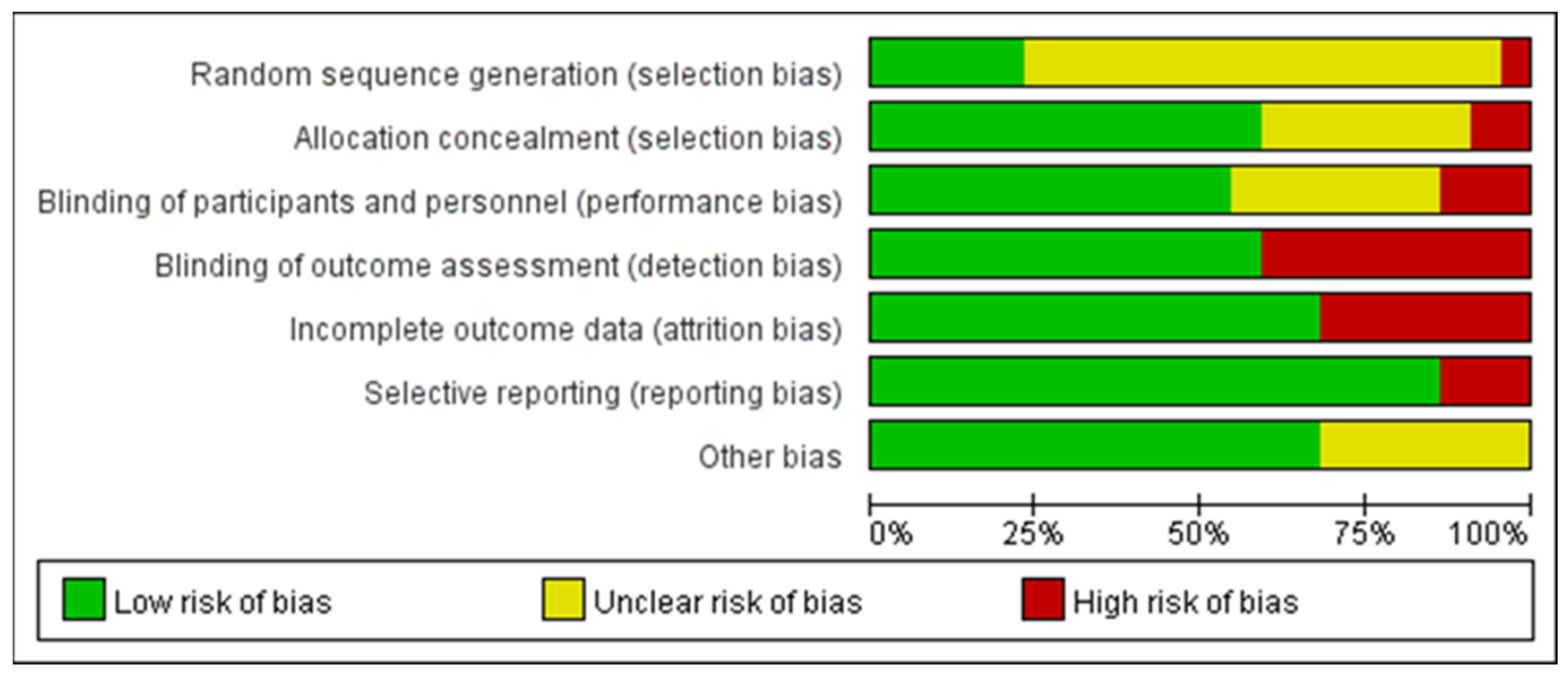
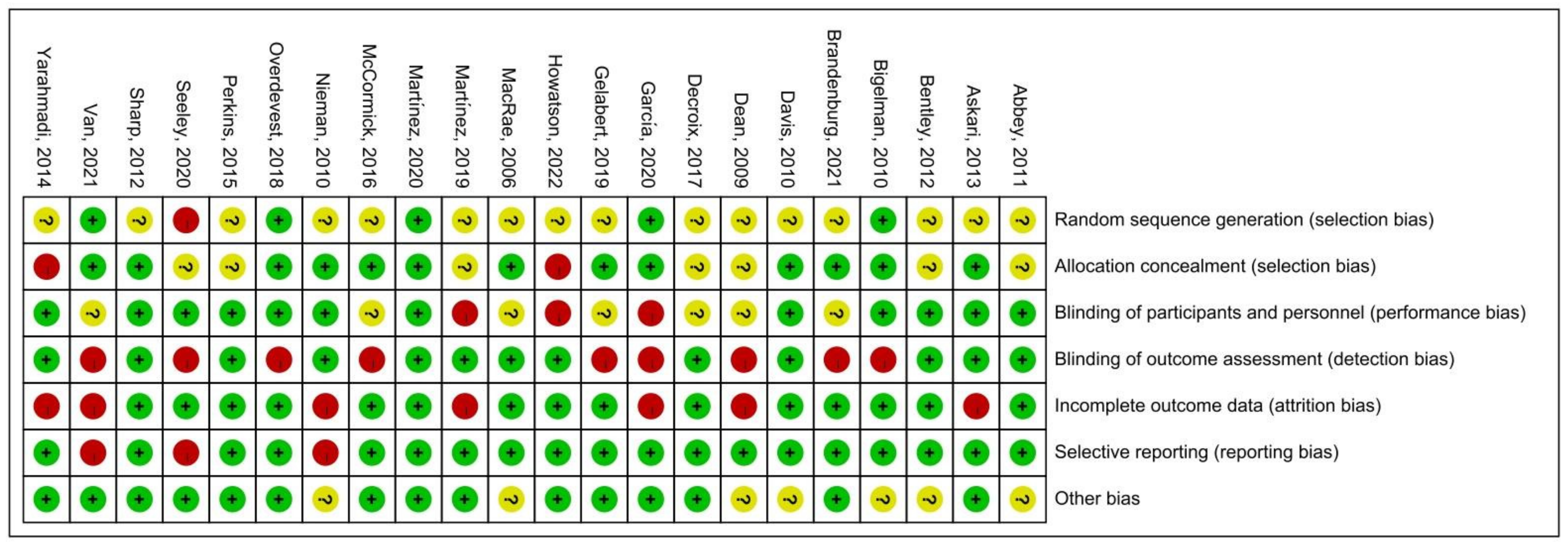
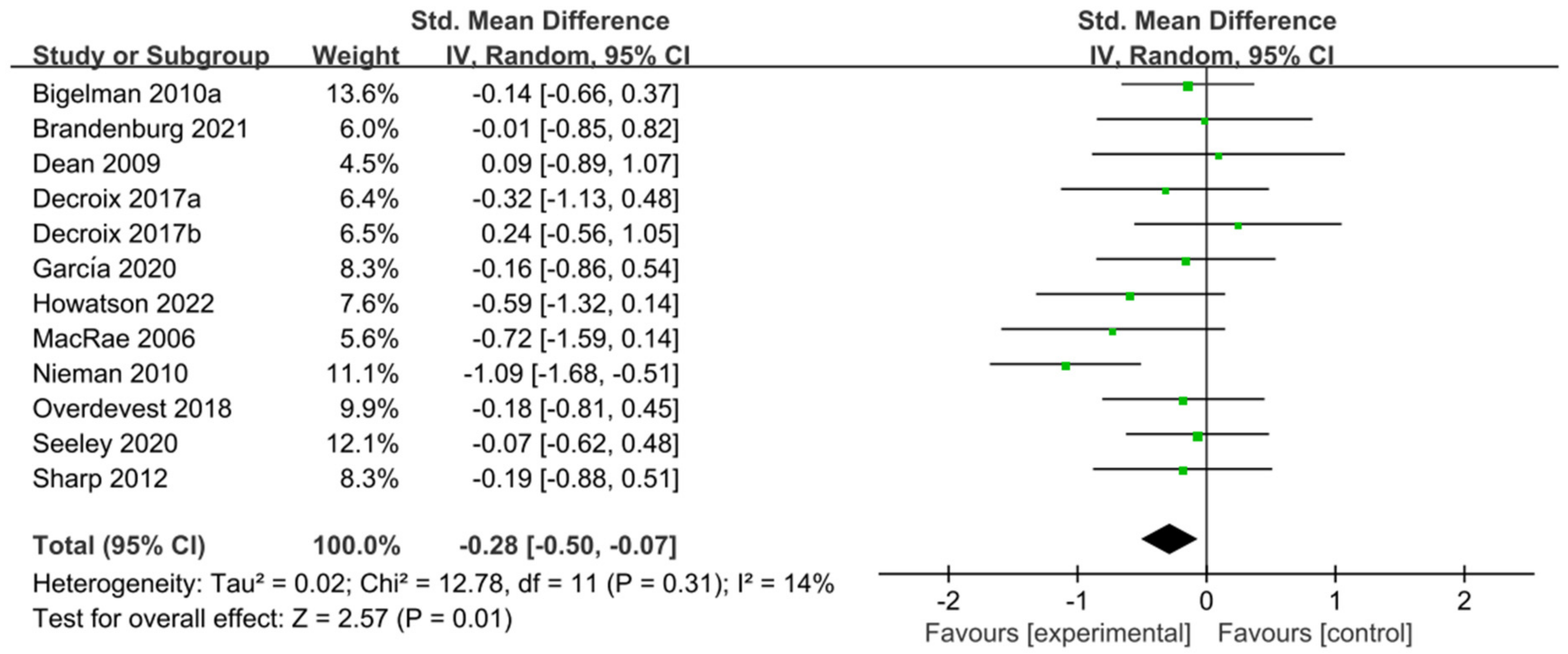

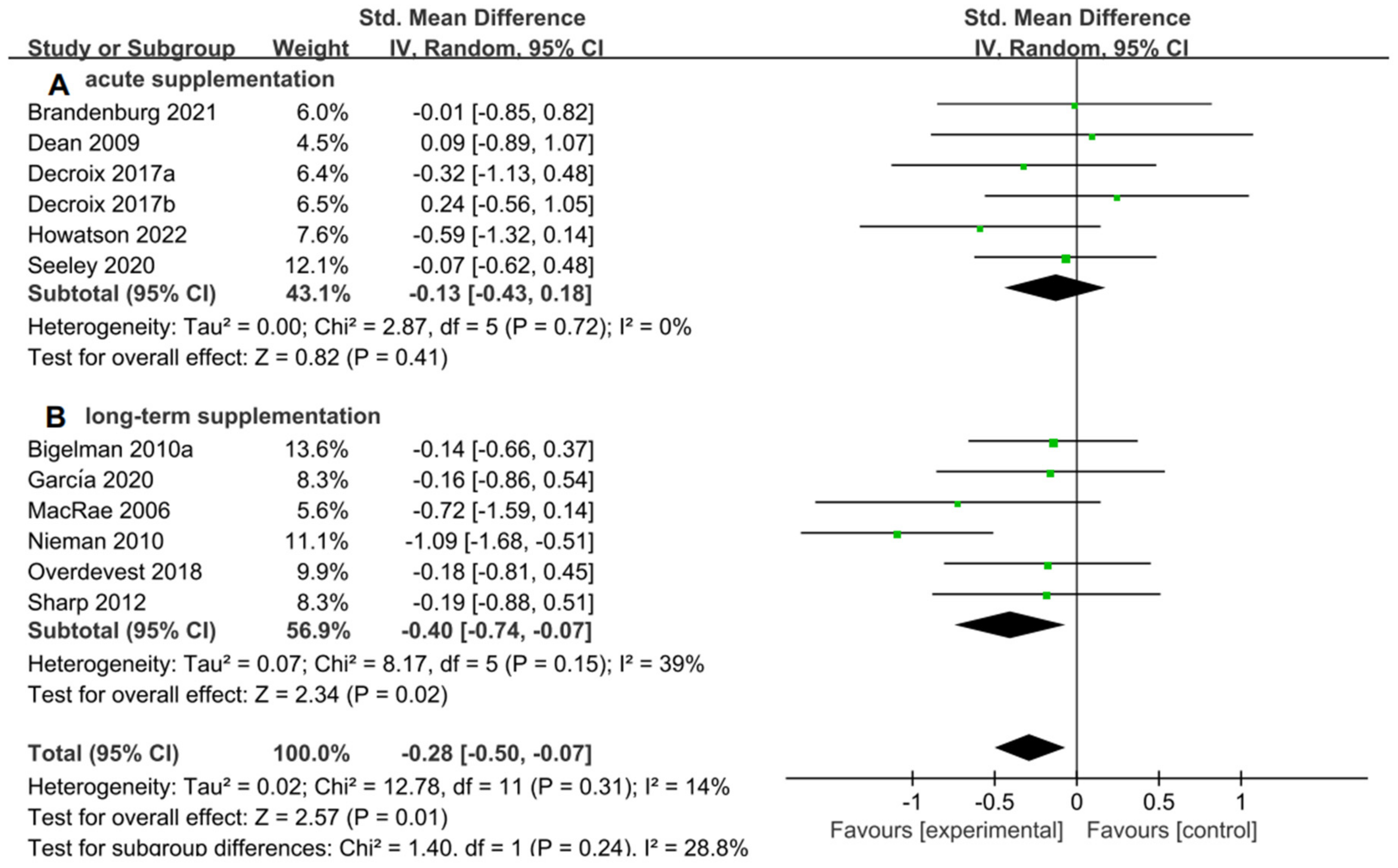
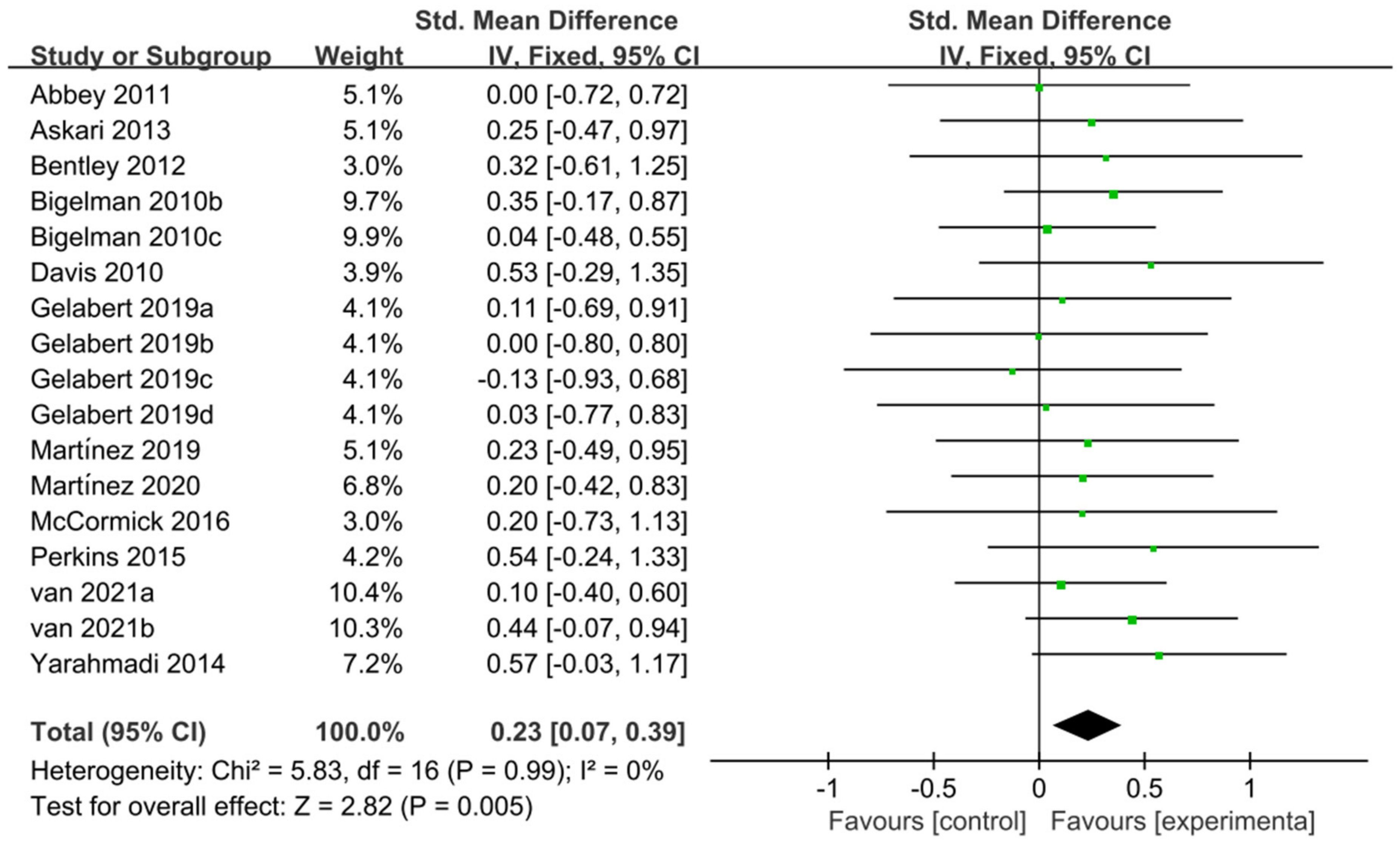
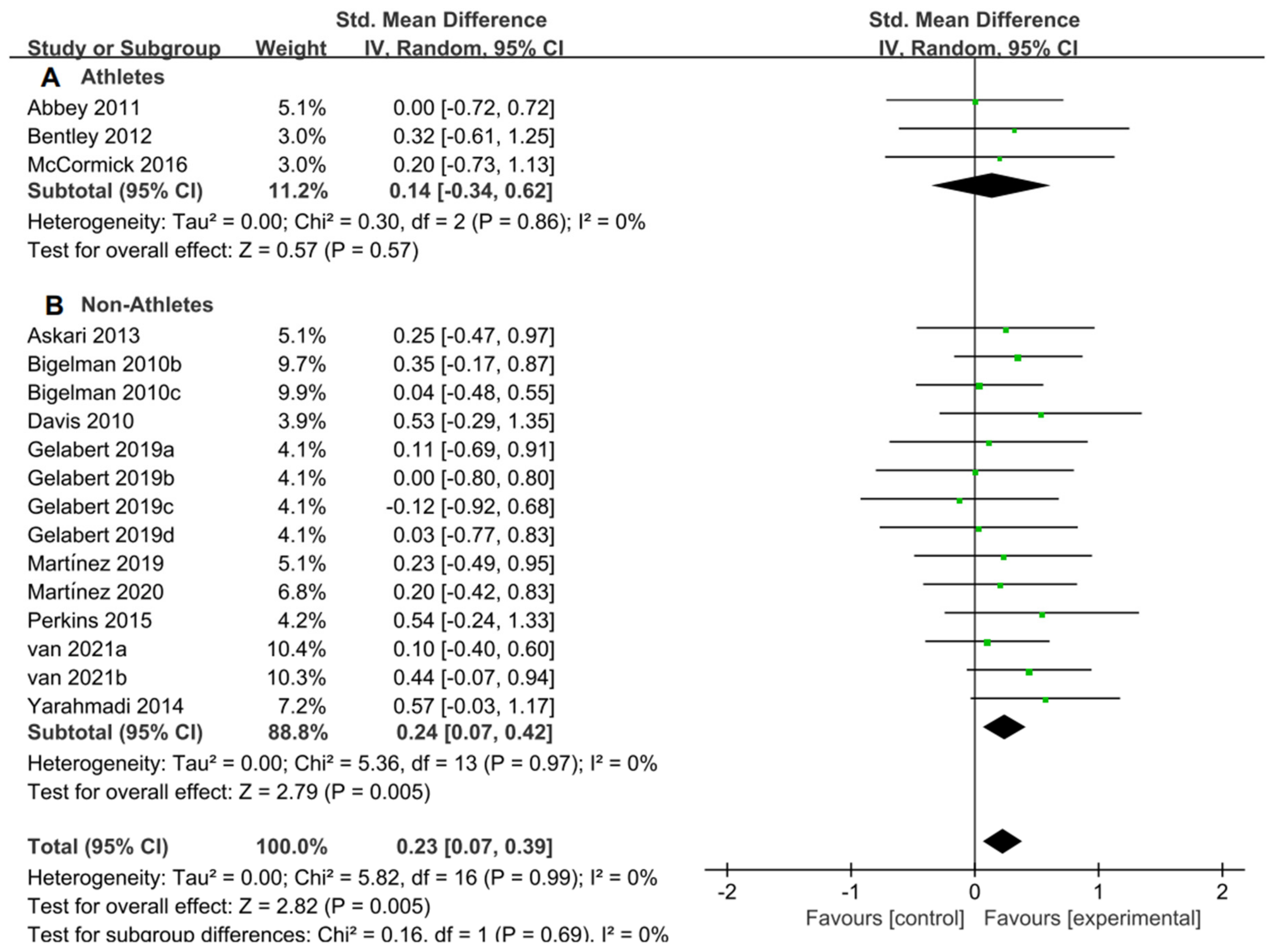
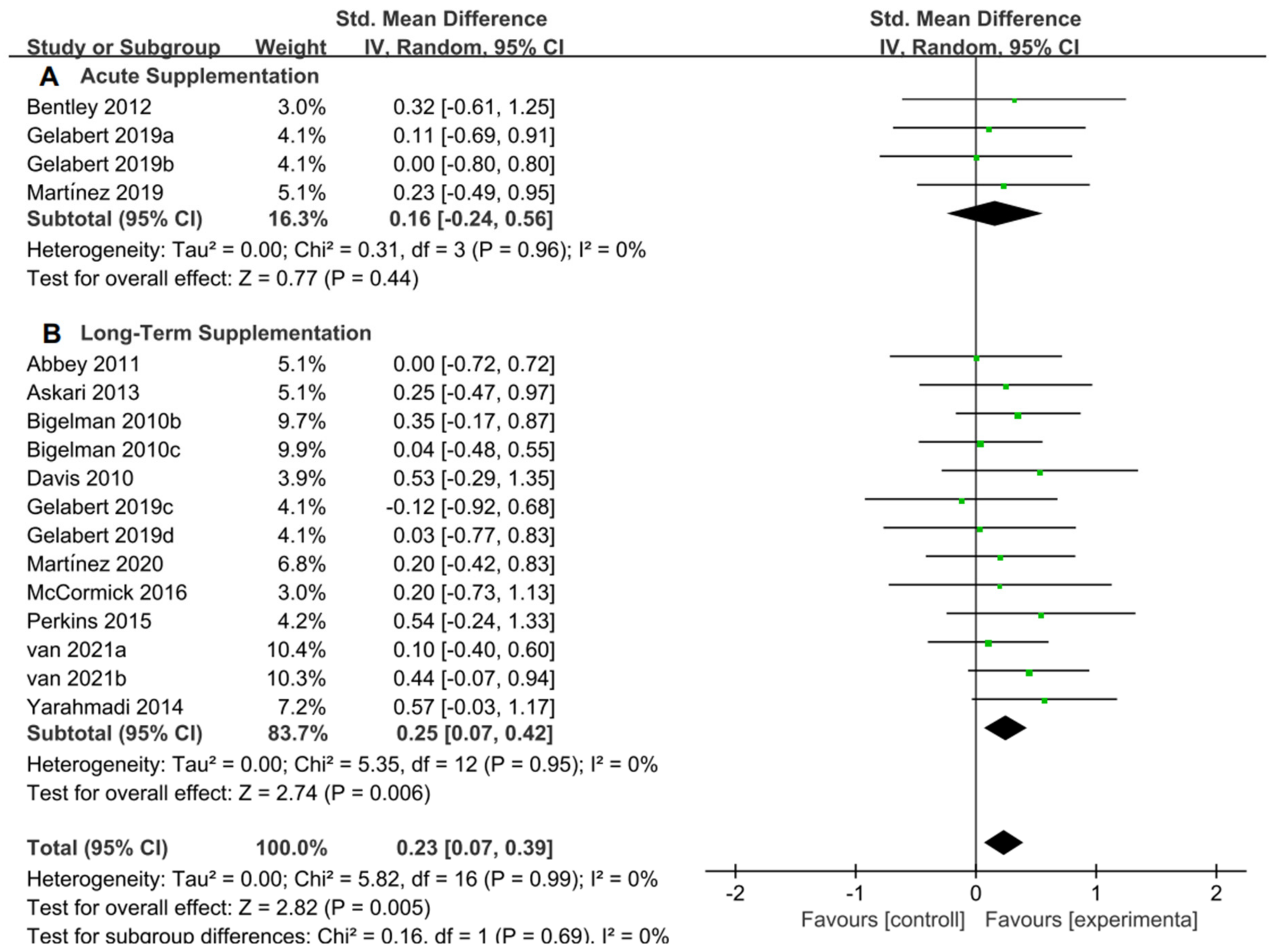
| PICOS | Standard |
|---|---|
| Population Intervention | Healthy adults Flavonoid supplementation |
| Comparator | Placebo |
| Outcome | Athletic performance |
| Study design | Randomized controlled trial (RCT) |
| Reference | Subject, n | Experimental Design | Intervention | Exercise Protocol | Outcomes | Trial Results (Mean ± SD) | Main Conclusion |
|---|---|---|---|---|---|---|---|
| Abbey, 2011 [28] | Athletes, n = 15 (males) | Double-blinded, cross-over, RCT | 1000 mg Quercetin a day for 7 days | 12 × 30-m sprints | Average times | Q = 4.85 ± 0.24 s P = 4.85 ± 0.24 s | → |
| Askari, 2013 [27] | Students with athletic history 3 years, n = 60 (males) | Double-blind, parallel, RCT | 500 mg Quercetin & 250 mg Vitamin C 500 mg a day for 8 weeks | Bruce protocol | Total distance | Q = 1289.07 ± 221.74 m P = 1233.92 ± 209.85 m | → |
| Bentley, 2012 [46] | Cyclists, n = 9 (males) | Double-blind, RCT | 150 mL Lactaway for once | Time to exhaustion | Total time | LA = 574 ± 265 s P = 494 ± 213 s | ↑ |
| Bigelman, 2010 [47] | Moderately trained person, n = 58 (44 males and 14 females) | Double-blind, parallel, RCT | 1000 mg Quercetin a day for 42–54 days | 2-mile running TT, Wingate anaerobic test, 36.6-m Sprint | Total time Mean power Total time | Q = 14.92 ± 1.74 min P = 15.17 ± 1.67 min (a) | → |
| Q = 551.72 ±110.99 W P = 513.21 ± 104.98 W (b) | → | ||||||
| Q = 5.78 ± 0.50 s P = 5.76 ± 0.52 s (c) | → | ||||||
| Brandenburg, 2021 [29] | Recreational runners, n = 11 (4 males and 7 females) | Double-blinded, cross-over, RCT | 324 g Blueberry a day for 4 days | 30 min TT in norm baric hypoxia | Total distance | BLU = 4.47 ± 0.69 km P = 4.46 ± 0.62 km | → |
| Davis, 2010 [20] | Student volunteers, n = 12 (7 males and 5 females) | Double-blinded, cross-over, RCT | 1000 mg Quercetin a day for 7 days | Endurance | Ride time | Q = 105.7 ± 21.8 min P = 93.4 ± 22.9 min | ↑ |
| Dean, 2009 [30] | Well-trained cyclists, n = 10 (males) | Double-blinded, cross-over, RCT | 270 mg Green-tea extract (TEAVIGO) a day for 5 days and 270 × 2 on Day 6 | 40-km Cycling TT | Total time | GT = 3652 ± 295 s P = 3627 ± 211 s | → |
| Decroix, 2017 [31] | Cyclists, n = 12 (male) | Double-blind, cross-over, RCT | 900 mg Cocoa Flavanols for once | Two 30 min running TT | Total time | CO = 29.22± 1.32 min P = 29.78 ± 1.97 min (a) | → |
| CO = 30.0 ± 1.58 min P = 29.57 ± 1.82 min (b) | → | ||||||
| García, 2020 [26] | Endurance cross-country athletes, n = 44 (males) | Blind, parallel, RCT | 5 g Cocoa a day for 10 weeks (425 mg of flavanols) | 1 km Running TT | Total time | CO = 3.15 ± 0.21 min P = 3.19 ± 0.27 min | → |
| Gelabert, 2019 [11] | Physical education students, n = 12 (male) | Double-blind, cross-over, RCT | L: 50 mg peanut and 140 mg MLE a day for 48 h and 15 days H: 100 mg peanut and 420 mg MLE a day for 48 h and 15 days | Incremental exercise test | Output power | 48 h MA + LU (L) = 288 ± 86.6 W P = 277 ± 103.9 W (a) | ↑ |
| MA + LU (H) = 291 ± 166.3 W P = 291 ± 166.3 W(b) | → | ||||||
| 15 days MA + LU (L) = 271 ± 83.1 W P = 282 ± 86.6 W(c) | → | ||||||
| MA + LU (H) = 291 ± 162.8 W P = 286 ± 145.5 W(d) | ↑ | ||||||
| Howatson, 2022 [48] | Volunteer, n = 30 (male) | Double-blind, parallel, RCT | Haskap (150 mg Anthocyanin) a day for 6 days | 5 km Running TT | Total time | Has = 1282 ± 140 s P = 1384 ±193 s | ↑ |
| MacRae, 2006 [49] | Elite cyclists, n = 11 (male) | Double-blind, cross-over, RCT | 600 mg Vitamins & Quercetin a day for 6 weeks | 30 km Cycling TT | Total time | FRS = 50.70 ± 2.22 min P = 52.30 ± 2.03 min | ↑ |
| Martínez, 2019 [50] | Amateur cyclists, n = 16 (male) | Single-blind, cross-over, RCT | 500 mg 2S-hesperidin for once | 4 × 30 s all-out sprints | Average power | 2S-hes = 567.84 ± 55.44 W P = 555.25 ± 51.81 W | ↑ |
| Martínez, 2020 [51] | Amateur cyclists, n = 40 (male) | Double-blind, parallel, RCT | 500 mg 2S-hesperidin a day for 8 weeks | Wingate test | Absolute peak power | 2S-hes = 860.6 ± 70.37 W P = 840.2 ± 118.93 W | ↑ |
| McCormick, 2016 [52] | Water polo players, n = 9 (male) | Double-blind, cross-over, RCT | 90 mL Cherry juice (9.117 mg/mL of anthocyanins) a day for 7 days | Water polo intermittent swim test | Total distance | CJ = 605 ± 239 m P = 558 ± 203 m | → |
| Nieman, 2010 [44] | Adults, n = 26 (male) | Double-blind, cross-over, RCT | 1000 mg Quercetin a day for 2 weeks | 12 min TT | Total distance | Q = 1013 ± 20.9 m P = 990 ± 20.5 m | ↑ |
| Overdevest, 2018 [53] | Trained athletes, n = 40 (male) | Double-blind, parallel, RCT | 500 mg Citrus Flavonoid a day for 4 weeks | 10 min TT | Absolut power | CF = 313 ± 43.6 W P = 304.3 ± 51 W | ↑ |
| Perkins, 2015 [54] | Healthy adults, n = 13 (males) | Double-blind, cross-over, RCT | 300 mg New Zealand Black Currant a day for 7 days | 6 × 19 s of sprints | Total distance | NZBC = 4282 ± 833 m P = 3871 ± 622 m | ↑ |
| Seeley, 2020 [55] | Cyclists and triathletes, n = 25 (male) | Double-blind, cross-over, RCT | 30 g Soy for once | 20-km TT | Total time | Soy = 35.31 ± 3.11 min P = 35.53 ± 3.09 min | ↑ |
| Sharp, 2012 [56] | Healthy volunteers, n = 16 (male) | Double-blind, cross-over, RCT | 1000 mg Quercetin a day for 8.5 day | 200-kJ Cycle TT | Total time | Q = 18.3 ± 1.0 min P = 18.5 ± 1.1 min | → |
| Van, 2021 [57] | Moderately trained volunteers, n = 93 (males and females) | Double-blind, parallel, RCT | 400 mg(a) or 500 mg(b) Citrus Flavonoid extract a day for 4 weeks | Wingate anaerobic test | Average power | CFE = 526 ± 150 W P = 511 ± 140 W (a) | ↑ |
| CFE = 575 ± 148 W P = 511 ± 140 W (b) | ↑ | ||||||
| Yarahmadi, 2014 [58] | Athletes, n = 54 (22 female and 32 male) | Double-blind, parallel, RCT | 100 mg Anthocyanin a day for 6 weeks | Bruce treadmill test | Vo2 max | Ant = 52.62 ± 5.04 L/min P = 49.61 ± 5.33 L/min | ↑ |
Disclaimer/Publisher’s Note: The statements, opinions and data contained in all publications are solely those of the individual author(s) and contributor(s) and not of MDPI and/or the editor(s). MDPI and/or the editor(s) disclaim responsibility for any injury to people or property resulting from any ideas, methods, instructions or products referred to in the content. |
© 2023 by the authors. Licensee MDPI, Basel, Switzerland. This article is an open access article distributed under the terms and conditions of the Creative Commons Attribution (CC BY) license (https://creativecommons.org/licenses/by/4.0/).
Share and Cite
Wang, Y.; Tian, Z.; Li, Z.; Kim, J.C. Effects of Flavonoid Supplementation on Athletic Performance in Healthy Adults: A Systematic Review and Meta-Analysis. Nutrients 2023, 15, 4547. https://doi.org/10.3390/nu15214547
Wang Y, Tian Z, Li Z, Kim JC. Effects of Flavonoid Supplementation on Athletic Performance in Healthy Adults: A Systematic Review and Meta-Analysis. Nutrients. 2023; 15(21):4547. https://doi.org/10.3390/nu15214547
Chicago/Turabian StyleWang, Ying, Zhuang Tian, Zhenyu Li, and Jae Cheol Kim. 2023. "Effects of Flavonoid Supplementation on Athletic Performance in Healthy Adults: A Systematic Review and Meta-Analysis" Nutrients 15, no. 21: 4547. https://doi.org/10.3390/nu15214547
APA StyleWang, Y., Tian, Z., Li, Z., & Kim, J. C. (2023). Effects of Flavonoid Supplementation on Athletic Performance in Healthy Adults: A Systematic Review and Meta-Analysis. Nutrients, 15(21), 4547. https://doi.org/10.3390/nu15214547





